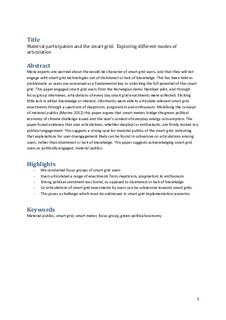| dc.contributor.author | Throndsen, William | |
| dc.contributor.author | Ryghaug, Marianne | |
| dc.date.accessioned | 2017-10-02T07:42:39Z | |
| dc.date.available | 2017-10-02T07:42:39Z | |
| dc.date.created | 2015-11-10T18:26:22Z | |
| dc.date.issued | 2015 | |
| dc.identifier.citation | Energy Research & Social Science. 2015, 9 157-165. | nb_NO |
| dc.identifier.issn | 2214-6296 | |
| dc.identifier.uri | http://hdl.handle.net/11250/2457614 | |
| dc.description.abstract | Many experts are concerned about the would-be character of smart grid users—specifically, that they will not engage with smart grid technologies out of disinterest or a lack of knowledge. This has been considered problematic because users are considered key to unlocking the full potential of the smart grid. This paper studied smart grid users from the Norwegian demo Steinkjer pilot and, through focus group interviews, collected articulations of everyday smart grid enactments. Eliciting little lack in knowledge or interest, users were able to articulate relevant smart grid enactments through a spectrum of skepticism, pragmatism and enthusiasm. Utilizing the concept of material publics [22], this paper argued that smart meters can bridge the green political economy of climate challenge issues with the user context of everyday energy consumption. The paper found evidence that user articulations, whether skeptical or enthusiastic, are rooted in political engagement as opposed to purely economic interest. This suggests a case for involving material publics in the smart grid and indicates that explanations for user disengagement can be found in active, subversive co-articulations among users rather than passive disinterest or a lack of knowledge. This paper suggests acknowledging smart grid users as politically engaged material publics. | nb_NO |
| dc.language.iso | eng | nb_NO |
| dc.publisher | Elsevier | nb_NO |
| dc.rights | Attribution-NonCommercial-NoDerivatives 4.0 Internasjonal | * |
| dc.rights.uri | http://creativecommons.org/licenses/by-nc-nd/4.0/deed.no | * |
| dc.title | Material participation and the smart grid: Exploring different modes of articulation | nb_NO |
| dc.type | Journal article | nb_NO |
| dc.type | Peer reviewed | nb_NO |
| dc.description.version | acceptedVersion | nb_NO |
| dc.source.pagenumber | 157-165 | nb_NO |
| dc.source.volume | 9 | nb_NO |
| dc.source.journal | Energy Research & Social Science | nb_NO |
| dc.identifier.doi | 10.1016/j.erss.2015.08.012 | |
| dc.identifier.cristin | 1287932 | |
| dc.relation.project | Norges forskningsråd: 220500 | nb_NO |
| dc.description.localcode | © 2015. This is the authors’ accepted and refereed manuscript to the article. This manuscript version is made available under the CC-BY-NC-ND 4.0 license http://creativecommons.org/licenses/by-nc-nd/4.0/ | nb_NO |
| cristin.unitcode | 194,62,40,0 | |
| cristin.unitname | Institutt for tverrfaglige kulturstudier | |
| cristin.ispublished | true | |
| cristin.fulltext | postprint | |
| cristin.qualitycode | 1 | |

